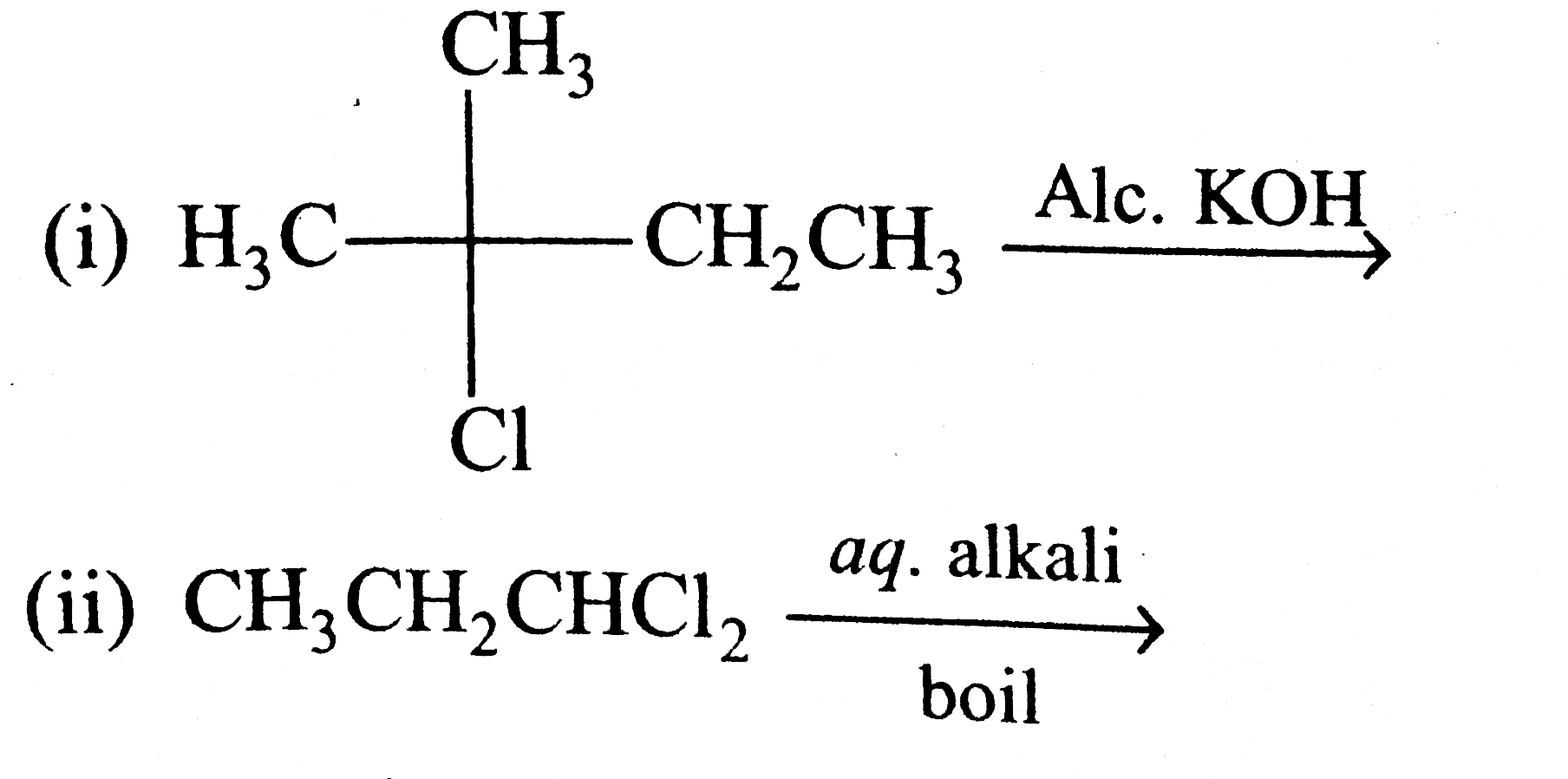Write the structure of the major organic product expected from each of the following reactions:
(CH3)2C∣Cl−CH2−CH3Alc.KOH−−−−−→
To determine the major organic product expected from the reaction of (CH₃)₂ClC−CH₂−CH₃ with alcoholic KOH, we will follow these steps:
Step 1: Identify the structure of the starting compound
The starting compound is (CH₃)₂ClC−CH₂−CH₃. This can be represented as:
CH₃∣∣CH₃−C−CH₂−CH₃∣∣Cl
This is 2-chloro-3-methylbutane.
Step 2: Understand the role of alcoholic KOH
Alcoholic KOH acts as a strong base. In this reaction, it will facilitate the elimination of HCl from the alkyl halide through an elimination reaction (E2 mechanism). The base will abstract a proton (H⁺) from a β-carbon, leading to the formation of a double bond.
Step 3: Identify β-hydrogens
In our compound, we need to identify the β-hydrogens (hydrogens on the carbon atoms adjacent to the carbon bearing the Cl atom). The β-carbons in this case are:
- The carbon adjacent to the carbon with Cl (which is CH₂-CH₃) has two β-hydrogens.
- The other β-carbon (the one with CH₃) has three β-hydrogens.
Step 4: Perform elimination
We can perform the elimination reaction from either β-carbon:
1. From the CH₂ group:
- Remove one H from CH₂, resulting in a double bond between the carbon with Cl and the adjacent carbon.
- This leads to the product:
CH₃∣CH₃−C=CH₂
(2-methylpropene)
2. From the CH₃ group:
- Remove one H from CH₃, resulting in a double bond between the carbon with Cl and the adjacent carbon.
- This leads to the product:
CH₂∣CH₃−C=CH−CH₃
(1-butene)
Step 5: Determine the major product
To determine which alkene is more stable, we consider the degree of substitution of the double bond:
- 2-methylpropene (formed from the CH₂ group) is a more substituted alkene (tertiary) compared to 1-butene (formed from the CH₃ group) which is less substituted (primary).
- More substituted alkenes are generally more stable due to hyperconjugation and the inductive effect.
Conclusion
The major product of the reaction is 2-methylpropene. The structure can be represented as:
CH₃∣CH₃−C=CH₂
The starting compound is (CH₃)₂ClC−CH₂−CH₃. This can be represented as:
CH₃∣∣CH₃−C−CH₂−CH₃∣∣Cl
This is 2-chloro-3-methylbutane.
Alcoholic KOH acts as a strong base. In this reaction, it will facilitate the elimination of HCl from the alkyl halide through an elimination reaction (E2 mechanism). The base will abstract a proton (H⁺) from a β-carbon, leading to the formation of a double bond.
In our compound, we need to identify the β-hydrogens (hydrogens on the carbon atoms adjacent to the carbon bearing the Cl atom). The β-carbons in this case are:
- The carbon adjacent to the carbon with Cl (which is CH₂-CH₃) has two β-hydrogens.
- The other β-carbon (the one with CH₃) has three β-hydrogens.
We can perform the elimination reaction from either β-carbon:
1. From the CH₂ group:
- Remove one H from CH₂, resulting in a double bond between the carbon with Cl and the adjacent carbon.
- This leads to the product:
CH₃∣CH₃−C=CH₂
(2-methylpropene)
- Remove one H from CH₃, resulting in a double bond between the carbon with Cl and the adjacent carbon.
- This leads to the product:
CH₂∣CH₃−C=CH−CH₃
(1-butene)
To determine which alkene is more stable, we consider the degree of substitution of the double bond:
- 2-methylpropene (formed from the CH₂ group) is a more substituted alkene (tertiary) compared to 1-butene (formed from the CH₃ group) which is less substituted (primary).
- More substituted alkenes are generally more stable due to hyperconjugation and the inductive effect.
The major product of the reaction is 2-methylpropene. The structure can be represented as:
CH₃∣CH₃−C=CH₂
Similar Questions
Write the structure of the major organic product expected from each of the following reactions:
CH3CH2CHCl2Boil−−→alkali
View SolutionWrite the structure of the major organic product in each of the following reaction :
CH3CH=C(CH3)2+HBr→
View SolutionWrite the structures of the major organic product expected from each of the following reactions :
(i)
(ii) CH3CH2CHCl2aq.alkali−−−−→boil
View SolutionWrite the structure of the major organic product in each of the following reaction :
(CH3)3CBr+KOHethanol−−−→heat
View SolutionWrite the structure of the major organic product in each of the following reaction :
CH3CH(Br)CH2CH3+NaOHwater−−→
View SolutionWrite the structure of the major organic product in each of the following reaction :
CH3CH2CH=CH2+HBrperoxide−−−−→
View SolutionWrite the structure of the major organic product in each of the following reaction :
CH3CH2CH2Cl+NaIacetone−−−→heat
View SolutionWrite the structure of the major organic product formed in each of following reactions:
CH3CH(Br)CH2CH3+NaOH△−−→
View SolutionWrite the structures of the major organic product formed in each of the following reaction:
(CH3)2CH−CH(Br)CH2CH3C2H5ONa−−−−−−−−→ethanol/heat
View SolutionWrite the structure of major organic product in each of the following reactions :
(a)(CH3)3CBr+H2Oheat−−→ (b)CH3CH2Cl+SbF3heat−−→
View Solution
